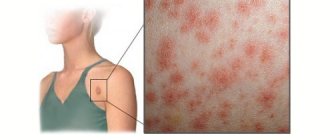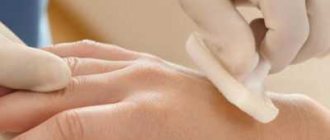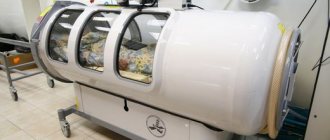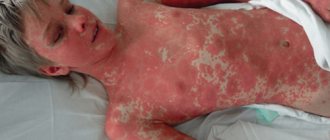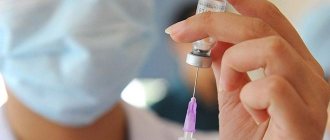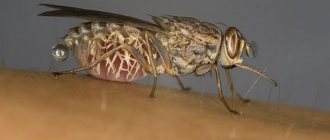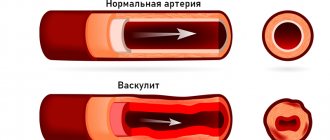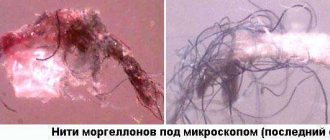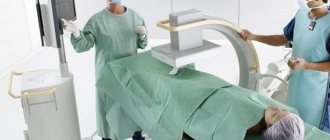Erythema infectiosum is sometimes called the “fifth disease” because it can be considered an “addition” to the well-known TORCH infections - herpes simplex, rubella, cytomegalovirus infection and toxoplasmosis.
Erythema infectiosum is a disease caused by paravirus B19. It affects people of all ages, but most often 4-11 year old children are affected. In adults, this form of erythema is observed relatively rarely, but can be more severe, especially in women over 30-35 years of age.
The viral variety of erythema during pregnancy is very dangerous; infection can lead to fetal death and miscarriage. Infection of a pregnant woman during the period from 10 to 26 weeks of pregnancy is especially dangerous for the fetus.
Causes of the disease
The reasons for the development of erythema infectiosum have not been sufficiently studied, although it is known for sure that the disease is caused by paravirus B19 (B19V) and as a consequence of this virus, viral exanthems may appear.
The infection is transmitted predominantly by airborne droplets, however, its contagiousness (susceptibility to infection) is low. There are other ways of transmitting the infection; the virus can enter the body through a blood transfusion from an infected person, and infection of the fetus occurs through the placenta.
Parovirus B19, which causes the development of erythema infectiosum, is a single-stranded, non-enveloped DNA virus with a diameter of 18-24 nm.
Erythema infectiosum usually manifests itself in sporadic outbreaks in child care institutions or families. After suffering from the disease, a person develops stable lifelong immunity.
It must be said that when conducting serological studies during outbreaks of the viral form of erythema, they show that approximately 80% of those examined experience the disease in a subclinical (asymptomatic) form.
Reasons for development
Fifth disease is caused by the human parvovirus B19 virus.
Erythema infectiosum in children and adults most often develops for the same reasons. At the initial stage, it causes only small rashes and mild discomfort, after which the condition stabilizes.
Although erythema infectiosum is transmitted through airborne droplets, outbreaks are low. A number of negative factors influence susceptibility to the virus:
- decreased immune response, often the disease develops against the background of fungal infections;
- blood diseases, especially those associated with impaired production of red blood cells;
- bad habits that weaken the body’s defenses: smoking, alcoholism, sedentary lifestyle.
Clinical picture of the disease
The incubation period for this type of erythema lasts about two weeks. Symptoms and manifestations of the infectious form of erythema strongly depend on subjective factors:
- Age of the patient;
- Presence of concomitant diseases;
- The presence of pathologies in the hematopoietic and circulatory system, etc.
The very first symptoms of erythema infectiosum resemble those of the flu. The patient experiences fever, itchy nose, runny nose, sore throat and sore throat, chills, headaches, general weakness, and lack of appetite. Sometimes these manifestations are so insignificant that the patient does not pay much attention to them.
A few days after the onset of the disease, a rash appears on the body. Although this symptom may be absent, the absence of a rash is especially common in adult patients.
As a rule, a rash with erythema infectiosum appears on the body according to a certain scenario.
It all starts with the eruptive phase of erythema, when a rash appears on the face. As a rule, the cheeks turn red first, becoming covered with roseola or roseola-papular elements, as in childhood roseola. The affected skin becomes bright red in color and outwardly the patient with the infectious form of erythema at this stage of the disease looks as if he had been struck on the cheeks. The affected skin is swollen, and individual elements of the rash are initially quite large (diameter 1 centimeter or more). Elements of the rash in the infectious form of erythema quickly grow and merge into solid plaques, which are symmetrically located on the cheeks. The skin of the forehead and chin is extremely rarely affected by this disease. The rash lasts 4-5 days, after which it resolves spontaneously.
The reticular phase of erythema infectiosum occurs approximately 2-3 days after the rash appears on the face. Sometimes both phases of erythema occur simultaneously. During this phase, rashes resembling a mesh or fancy lace appear on the skin of the limbs, buttocks and torso. There are no subjective sensations (pain, itching) with erythema. The rashes disappear 6-14 days after their appearance.
Subsequently, with erythema infectiosum, a relapse phase begins, which can last 2-3 weeks. This phase of erythema is characterized by the occurrence of repeated rashes in the same areas of the skin. Stress, temperature changes, overheating or hypothermia can trigger the appearance of a secondary rash.
The rash in the infectious form of erythema resolves without leaving traces in the form of peeling or pigmentation or keloid scars. Sometimes patients experience mild lymphopenia or lymphocytosis.
Joint syndrome
The next stage of erythema infectiosum is characterized by the development of symmetrical polyarthritis of moderate severity. Symptoms at this stage of the disease are similar to those of rheumatoid polyarthritis.
Joint lesions with erythema begin to appear with the onset of production of IgG and immune complexes in the body, which cause damage to joint tissue. Polyarthritis can last from 2-4 weeks to 3-4 years; in some cases, joint damage is migratory.
With infectious erythema in children, the articular syndrome most often manifests itself as acute arthritis with a short course; in some cases, the articular syndrome manifests itself exclusively as arthralgia (the appearance of pain in the joints without tissue damage). In children, in approximately 80% of cases, only the knee joints are affected.
The duration of this phase of erythema infectiosum is 3-4 months, sometimes it can last for a year. Such a long course of articular syndrome often leads to an incorrect diagnosis – juvenile rheumatoid arthritis.
To exclude errors, it is necessary to order laboratory tests. With erythema infectiosum, laboratory values remain within normal limits.
Infection during pregnancy
As already noted, infection with paravirus B19 is especially dangerous during pregnancy. Erythema infectiosum in a pregnant woman leads to infection of the fetus and the development of severe anemia, heart failure and generalized edema, which can lead to intrauterine death. In approximately 10% of cases, infection with paravirus B19 leads to spontaneous abortion.
Possible complications
Erythema infectiosum can provoke the development of complications, which are especially common in children.
This type of erythema can cause a suspension of red blood cell synthesis. If a person was initially healthy, then such a complication, in most cases, is invisible. However, if there were problems with the blood system before infection (for example, thalassemia, sickle cell anemia), then the cessation of red blood cell synthesis can lead to an aplastic crisis lasting 7-10 days.
The infectious type of erythema is difficult to tolerate in patients with aplastic anemia. In this case, patients experience rapid heartbeat, severe attacks of fever and other extremely unpleasant symptoms.
Erythema infectiosum is also dangerous for people with immunodeficiency. In such patients, the disease often becomes chronic, which ultimately leads to the development of severe pathologies of the hematopoietic system and persistent anemia.
What complications can occur after erythema infectiosum?
In some cases, the disease may be complicated:
1. The synthesis of red blood cells is suspended. Healthy people do not notice this complication; they do not have problems with blood. If a person suffers from a problem with hematopoiesis, he may have serious pathologies with the circulatory system - thalassemia and anemia.
2. Erythema infectiosum is dangerous for people who suffer from aplastic anemia. At the same time, the patient feels apathy, his heartbeat quickens, and fever occurs.
3. This disease is dangerous for children who have problems with immunodeficiency; it develops into a chronic form, as a result of which hematopoiesis and bone marrow are affected and persistent anemia occurs.
Diagnostic methods
Clinical and laboratory diagnosis of the infectious form of erythema is a very difficult task, since the symptoms of the disease are similar to those of many other diseases.
Upon external examination, erythema infectiosum should be suspected by the typical, “lacey” appearance of the rash.
To make a correct diagnosis, it is necessary to carry out a number of tests, in particular:
- Serological examination to detect antibodies to the virus.
- Conducting a general analysis to determine the level of red blood cells, platelets and leukocytes in the blood.
A complete blood count should also be performed during treatment so that the effectiveness of the therapy can be assessed.
A differentiated diagnosis is required with diseases such as:
- Measles;
- Scarlet fever;
- Rubella;
- Drug toxicity and drug rash;
- Exudative erythema.
When fields appear in the joints, it is necessary to distinguish the infectious form of erythema from:
- Rheumatoid arthritis and the appearance of rheumatoid nodules with it;
- Borreliosis.
Erythema infectiosum - causes, symptoms, treatment, photos
The main clinical forms of erythema are:
Infectious erythema of Rosenberg (Erythema infectiosum Rosenberg)
has an acute onset and is manifested by severe fever, as well as symptoms of general intoxication (myalgia, arthralgia, severe headache, insomnia).
On the 3-6th day, a profuse maculopapular or macular rash appears, most often forming on the extensor surfaces of the extremities, condensing in the area of large joints and on the buttocks, where they merge into continuous erythematous fields. There is no rash on the face. After 6-7 days, the exanthema disappears, leaving pityriasis-like or lamellar peeling.
Fever lasts 9-12 days. The spleen and liver are often enlarged. In some patients, joints may swell and meningeal symptoms may appear.
Erythema infectiosum Tschamer.
The incubation period of Chamera erythema lasts from 10 to 14 days. The disease is mild. It mainly affects children. Body temperature is normal or subfebrile.
From the 1st day of illness, a characteristic rash appears on the patient’s face, first in the form of small spots, then these spots merge and form a butterfly-like figure. Some elements of the rash may appear on the limbs and torso. Further, the elements of the rash gradually fade, starting from the center. Exanthema lasts quite a long time, at least 2 weeks.
Sometimes a rash that has almost disappeared can reappear in the same place. The reappearance of the rash can be triggered by overheating, fever or physical exertion. Some patients experience moderate inflammatory changes in the upper respiratory tract and conjunctival hyperemia. Mostly in adults, mild pain and slight swelling of the joints are noted.
The causative agent of this infection has now been identified as human parvovirus (B 19). The disease is most often asymptomatic, because Antibodies to this virus are found in 25-45% of healthy people.
Erythema nodosum
– this disease is manifested by a number of infectious diseases, such as tuberculosis, tularemia, rheumatism, etc.). It is characterized by an increase in body temperature (if the temperature has not already been increased due to the underlying disease), aching pain in the extremities, especially in large joints, and a characteristic exanthema.
The rash appears symmetrically on the legs and forearms, much less often on the feet and thighs. The elements of the rash look like nodes with a diameter of 4 to 5 cm, dense and painful when pressed, rising above the skin level, an infiltrate can be felt deep in the skin.
The skin over the nodes is initially red, then it becomes cyanotic and when the infiltrate decreases, the color becomes greenish-yellowish. The nodes last for 2 to 3 weeks.
Multiform (polyform) exudative erythema (Erythema exidativa multiforme)
exudative erythema (Erythema exidativa multiforme) is manifested by fever (body temperature 39-40°C), as well as symptoms of general intoxication - arthralgia, headache, weakness.
On the 3-6th day, a profuse polymorphic rash appears, which covers the limbs and torso. Symmetrical rashes are rarely observed. The elements of the rash look like spots or papules. Particularly characteristic is the appearance of bubbles that are filled with transparent contents.
When a bladder ruptures, a red abrasion first forms in its place, and then a brownish crust. The rash is also accompanied by itching and burning of the skin. A more severe type of erythema is Stevens-Johnson syndrome.
In addition to skin damage, erosive and ulcerative changes occur in the mucous membrane of the mouth, nasopharynx, genitals, and anus. The disease usually goes away within 1-3 weeks, and Stevens-Johnson syndrome - up to 6-7 weeks or more. There are also deaths.
Sudden exanthema (Erythema subitum).
The incubation period of the disease is 4 to 5 days. The disease begins acutely, body temperature reaches 38-40°C and rises quickly, symptoms of general intoxication are relatively moderate. After 3-4 days, the temperature drops to normal, and at this time an exanthema appears (or after 2-3 days), involving the torso, face, and limbs.
The elements of the rash look like small pale pink spots up to 5 mm in diameter, which sometimes merge, resembling the rash of measles (but it is not as bright) or like rubella. After 3 days, the rash completely disappears, without even leaving behind peeling or pigmentation.
In the blood in the first days of the disease, neutrophilic leukocytosis is observed, and when a rash appears, lymphocytosis, leukopenia, and neutropenia are observed.
Undifferentiated erythema infectiosum
is a collective group of infectious diseases of unknown etiology, characterized by fever, symptoms of intoxication are moderate, and exanthema appears, which is not characteristic of any infectious disease.
Source: //dermhelp.ru/disease/infekcionnaya-ehritema
Treatment using official medicine methods
For erythema infectiosum in children and adults, hospitalization is usually not required. The principle of treatment for this disease is similar to the scheme adopted for the treatment of any other viral infections.
- During a febrile state with erythema infectiosum, bed rest is indicated.
- It is necessary to take a large amount of liquid.
- Antiviral drugs and medications are prescribed to alleviate the symptoms of the disease.
- The appearance of the second and subsequent waves of the rash is not an indicator of the severity of the disease; with erythema infectiosum it is simply a characteristic feature of the disease.
- During the treatment of erythema, you should avoid exposure to the open sun or solarium, and you should limit taking hot baths.
- Since erythema infectiosum is a viral disease, antibiotics are not prescribed for its treatment. However, antibacterial therapy may be required if microbial complications, pneumonia, sore throat or otitis media are added to the erythema.
Manifestations of erythema infectiosum, forms of the disease, diagnosis and treatment
Erythema infectiosum is a viral disease with predominantly skin manifestations.
This name combines a group of acute conditions with approximately the same symptoms and a similar course.
Initially, they were described as independent diseases, but later they began to be considered varieties of one disease.
Etiology of the disease
For a long time, the causes of erythema infectiosum were unknown. Currently, infection with parvovirus B19 is considered the main etiological factor. This DNA-containing virus was identified in 1974 from human blood serum and received its name from the number and series of the plasma sample being studied. Since July 2013, it has been called Primate erythroparvovirus 1.
The infection is transmitted from an infected person by airborne droplets and vertically (transplacentally from mother to fetus). There is also a risk of infection from transfusions of blood and its components, as well as from organ transplants from a donor infected with parvovirus. But the likelihood of this is low, because the pathogen is not prone to long-term persistence in the human body.
The main target of the virus is erythroid progenitor cells in the bone marrow. In the fetus, cord blood erythroblasts and the fetal liver, the main extramedullary hematopoietic organs, are also affected. This can cause clinically significant disturbances in erythropoiesis, although most often the peripheral blood pattern remains virtually unchanged.
Why a rash appears in certain areas of the body and other symptoms of erythema infectiosum is still not reliably known. The most striking manifestations of the disease are observed in patients with a tendency to hypersensitivity.
Often a characteristic rash appears against the background of other diseases: rheumatism, tularemia, tuberculosis. Taking sulfa drugs is also considered a factor that contributes to a more severe and complicated course of erythema infectiosum.
Immunodeficiencies of various etiologies operate in the same way.
Classification
Currently, there are several types of erythema infectiosum:
- sudden exanthema - characterized by the fastest and mildest course;
- infectious erythema of Chamera - most often observed in children;
- erythema infectiosum of Rosenberg;
- erythema nodosum;
- exudative erythema multiforme, its most severe variant is called Stevens-Johnson syndrome;
- undifferentiated form (according to the classification of A.I. Ivanov).
These conditions cannot be transformed into each other; each of them has its own characteristics of the course and nature of the rash.
Clinical picture
The incubation period lasts 1-2 weeks (less often it stretches to 28 days), and the duration of the disease averages from 1 to 3 weeks. The only exception is the severe form of the disease (Stevens-Johnson syndrome), which can last more than 1.5 months.
Symptoms consist of signs of intoxication and exanthema (rash). Moreover, fever always precedes skin manifestations and may decrease after the appearance of rashes.
In some forms of the disease, arthralgia and arthropathy also appear; moderate hepato- and splenomegaly and mild meningeal syndrome may be observed.
Anemia, leukopenia and neutropenia are signs of massive damage to bone marrow cells.
The rash with erythema infectiosum is profuse, confluent, predominantly macular, roseolous and maculopapular. Some forms of the disease are also characterized by the appearance of nodes or vesicles.
Exanthema on the face leads to the appearance of “spanked cheeks” with diffuse redness. And on the extremities, the rash usually resembles lace and consists of merging round spots, rings and half-rings.
The nature and localization of the rashes are the basis for diagnosing the types of erythema infectiosum, and this has virtually no effect on the treatment regimen.
Elements of exanthema gradually fade and disappear, while the spots become ring-shaped. This phase of the rash is called the reticular phase. In some cases, lamellar or pityriasis-like peeling persists for a short time in areas of severe rash. The disease does not leave behind external defects: scars, areas with altered pigmentation, thickening or thinning of the skin.
Features of different forms of the disease
Sudden exanthema
It is characterized by a rapid and significant increase in body temperature, which is accompanied by general moderate intoxication. On days 3-4, there is a rapid critical resolution of the fever with the simultaneous appearance of spotty rashes on the face, limbs, and torso. The rash persists for no more than 3 days and then disappears spontaneously and without a trace.
Erythema infectiosum of Chamera
This form is not characterized by severe fever and severe intoxication; the temperature is usually low-grade or normal. A spotty rash appears from the first day of illness and is localized mainly on the face.
The fusion of its individual elements leads to the appearance of the “butterfly” symptom. Waves of repeated rashes are possible, which usually appears against the background of respiratory infections and hypothermia.
Erythema infectiosum of Chamera in adults may be accompanied by mild arthropathy. And children tolerate the disease easily.
Diagnostics
Diagnosis of erythema infectiosum is based on the characteristics of the clinical picture. In this case, it is necessary to exclude many diseases that occur with exanthema.
Infectious erythema is differentiated from measles, rubella, erysipelas, scarlet fever, leptospirosis, cutaneous leishmaniasis, typhus, systemic lupus erythematosus, infantile roseola and other diseases.
And with erythema multiforme, serum sickness and drug toxicderma are excluded.
To verify the diagnosis in difficult cases, PCR is used (allows detection of viral DNA) and ELISA (determining the titer of specific antibodies of different classes). A high level of Ig G to parvovirus in the absence of Ig M indicates a previous disease.
Treatment
Treatment of erythema infectiosum depends on the severity of the main symptoms. A mild disease requires only symptomatic therapy: antipyretics and local antipruritics.
If necessary, antihistamines are added, especially in the case of erythema nodosum.
Sulfonamides must be discontinued if they were prescribed for the treatment of a previous infectious disease.
Severe course and signs of exudative erythema multiforme are the basis for starting corticosteroid therapy. It is also necessary if the patient has an immunodeficiency. In some cases, various antiviral drugs are prescribed, although they do not have a narrowly targeted effect on parvovirus.
Forecast
Erythema infectiosum in children and adults is usually quite mild, rarely complicated and does not pose a threat to life. An exception is Stevens-Johnson syndrome, which is sometimes fatal.
If a person has a history of previous blood disorders, erythema infectiosum may be complicated by anemia. The most severe form of this condition is aplastic crisis, requiring transfusion of blood or its individual components.
When a pregnant woman is infected, there is a risk of intrauterine fetal death. Therefore, another name for erythema infectiosum is fifth disease.
This is explained by the fact that many doctors equate it to the TORCH group, which includes the potentially teratogenic rubella, toxoplasmosis, herpes and cytomegalovirus infection.
Viral erythema is most dangerous during the gestational period of 10-26 weeks; infection during this period can cause miscarriage. But this infection does not pose a threat to the life of the pregnant woman herself.
Erythema infectiosum leaves behind lifelong immunity, regardless of the severity of symptoms. Specific antibodies are formed even in the latent (inapparent, asymptomatic) form of the disease. Often people learn about parvovirus infection only after a serological test.
Prevention
Viral erythema is not a highly contagious infection and has no specific prevention. General improvement of the body, reduction in the level of allergization, timely and competent treatment of underlying diseases help reduce the risk of complications.
A pregnant woman is advised to avoid crowds, use masks if necessary, rinse her mouth and wash her nose after contact with a patient suspected of erythema infectiosum. If a fever and rash develop, she needs to see a doctor as soon as possible and get tested.
Source: //BellaEstetica.ru/dermatologiya/infekcionnaja-eritema.html
Treatment using traditional medicine methods
Herbal medicine methods can be used as an addition to the doctor-selected treatment for erythema infectiosum.
For this form of erythema, it is useful to use a tincture prepared from Rhodiola rosea, Schisandra chinensis or ginseng. You need to take any of the above-mentioned plants and grind them into powder if the raw materials are dry, or into a paste if the grass is fresh. The prepared raw materials are poured with high-quality vodka; for 1 part of grass you need to take 10 parts of vodka. Leave in a dark place for two weeks. Take, after filtering, 20 drops three times a day before meals.
To treat infectious erythema, you can prepare an infusion of the following medicinal plants: willow bark, birch leaves, black elderberry flowers. All ingredients are mixed in equal parts. Then take one spoonful of the prepared dry mixture per glass of boiling water and simmer at the lowest boil (preferably in a water bath) for five minutes. Then turn off the heating, cover the dish with a lid and leave until completely cool. Strain off the liquid and divide it into three portions. Take during the day before meals.
Using a similar scheme, you can prepare an infusion of knotweed herb, golden rod and string. This infusion helps to quickly cope with infectious erythema.
Infectious (viral) erythema in children and adults: treatment and symptoms of fifth disease
Photo from drshibumohammed.com
There are several types of infection, which differ in clinical course. They usually get sick only once in childhood; immunity is acquired for life. Adults become infected only during the initial encounter with the pathogen.
Causes
Erythema infectiosum, or fifth disease, is one of the five most common infections that are accompanied by skin rashes. The cause of the pathology is parvovirus B19, which leads to anemia and the appearance of spots on the skin.
A child can become infected in the following ways:
- transplacental - when in the womb;
- parenterally – in case of damage to the skin and mucous membranes;
- airborne - when the virus is inhaled through the lungs.
Once in the body, the virus finds target cells, penetrates the cytoplasm and destroys them from the inside. The concentration of red blood cells gradually decreases, which leads to anemia and hemoglobin deficiency.
The causative agent of erythema infectiosum has a unique feature - it multiplies inside the cells of the bone marrow, intestines and embryo. Because of this, there is a risk of infection in the absence of immunity in the mother.
Symptoms
The clinical manifestations of the disease are preceded by an incubation period - it lasts from several days to 2 weeks. During this time period, the virus enters the body and infects healthy tissue, but no signs of pathology are detected. The first manifestations of the disease gradually appear.
Viral erythema in children is accompanied by the following symptoms:
- Rash - localization depends on the type of erythema infectiosum. Formations are found on the limbs, torso, and neck. Pink spots usually appear on the skin, which may rise slightly above its surface.
- Fever - the temperature can rise to 38º C. Usually the symptom appears along with skin rashes and accompanies the disease until a period of complete recovery.
- Symptoms of intoxication - patients complain of weakness, a feeling of loss of strength and muscle aches. Chills and decreased interest in the environment are often noted.
- Pain in joints and muscles does not always appear, more often in adults. Arthralgia is usually noted in the extremities, discomfort in the muscles is felt when moving.
The severity of symptoms and the location of lesions depend on the type of erythema infectiosum. In many patients, the pathology is asymptomatic or mild. Children or weakened patients require constant monitoring by medical personnel.
Kinds
There are several types of erythema infectiosum in children and adults; the classification is based on the clinical signs of the disease. The gradation also takes into account the characteristics of skin rashes and the time of onset of the first symptoms.
Types of disease:
- Infectious erythema of Chamera is a mild form of pathology, characterized by the appearance of small spots on the face, which gradually merge into a single field. The temperature may be absent or rise to low levels. Exacerbations occur rarely, only with overheating or hypothermia.
- Ring-shaped erythema - with this form, ring-shaped rashes appear on the skin, which can merge with each other. The disease often occurs together with autoimmune pathologies and can affect both adults and children. Read more about ring-shaped erythema→
- Infectious erythema of Rosenberg - begins abruptly, accompanied by fever, enlargement of the liver and spleen. The rash appears on the face, in the area of the flexor surfaces of the joints. The spots can grow and merge with each other. At the site of wounds, the skin becomes rough, peels and leaves small light fields that disappear over time.
- Erythema nodosum - often appears against the background of infectious diseases, is accompanied by an increase in body temperature, discomfort in the limbs and the appearance of painless nodules. Read more about erythema nodosum→
- Exudative erythema - blisters filled with fluid appear on the skin. They gradually burst and dry out. The disease is also accompanied by fever and symptoms of intoxication. Read more about exudative erythema→
- Sudden erythema - this form is distinguished based on the clinic. It is characterized by a sharp rise in temperature to high numbers, the appearance of intoxication, pain in the limbs and rash.
- Undifferentiated - this form does not fit any of the above. The clinic is blurred, the rash is localized on any part of the body.
The attending physician will help you accurately determine the form of erythema based on examination and collection of complaints. Treatment of the pathology does not greatly depend on its type; when choosing medications, they are guided by the severity of symptoms and the age of the patient.
Treatment of erythema infectiosum in children
Photo from farmlend.ru
When erythema is detected in children, gentle treatment is necessary, which is aimed at maintaining the vital functions of the body and eliminating symptoms. For this, the child is prescribed:
- bed rest;
- drinking plenty of water;
- taking vitamins (Complivit, Suprastin);
- analgesics for pain (Aspirin, Nise);
- drugs for the treatment of concomitant diseases - if any (antibiotics, immunostimulants, antirheumatic drugs, etc.).
Physiotherapy can also be performed - UVT, medicinal electrophoresis, radon baths. Such procedures are prescribed at the final stage of treatment of erythema infectiosum.
Treatment of erythema infectiosum in adults
Erythema infectiosum in adults is usually characterized by a more severe course, so the therapeutic program is expanding. In addition to bed rest and detoxification therapy, the following are prescribed:
- antihistamines (Suprastin, Tavegil);
- nonsteroidal anti-inflammatory drugs (Ketanov, Nimesulide);
- corticosteroid drugs (Betamethasone, Hydrocortisone).
After eliminating the pain, the rash gradually decreases and discomfort disappears. Physiotherapy is also a good option for rehabilitation.
Consequences
Infectious erythema of the skin in children rarely leads to complications; the disease is usually asymptomatic without severe impairment. There is a risk of developing chronic hypoxia against the background of anemia, which is accompanied by episodic loss of consciousness. In adults, the risk group includes pregnant women, in whom the disease can cause miscarriage.
about erythema infectiosum
List of sources:
- Dermatovenerology. National leadership / Ed. Yu.K. Skripki-na, Yu.S. Butova, O.L. Ivanova. - M.: GEOTAR-Media, 2011. - 1024 p. — (Series “National Guidelines.”)
- Clinical dermatovenerology: in 2 volumes / Ed. Yu.K. Skripkina, Yu.S. Butova. - M.: GEOTAR-Media, 2009.
- Chebotarev V.V., Baida A.P. Guide for general practitioners (family doctors) on dermatovenerology. - Stavropol: Seventh Heaven, 2009. - 328 p.
Source: //dermatologiya.pro/nasledstvennye-bolezni/eritema/infekcionnaya.html
Prevention and prognosis
The prognosis for erythema infectiosum is favorable. The patient is subject to isolation from the moment flu-like symptoms appear, but after the appearance of the rash does not pose a danger to others. Therefore, if you feel normal with erythema infectiosum, you can lead your usual lifestyle.
Unfortunately, you can also become infected with erythema infectiosum from a carrier of the virus or from a patient whose disease is asymptomatic. It is impossible to recognize such people, so there are no effective preventive measures. However, you can reduce the risk of getting an infection. For this it is recommended:
- If possible, avoid contact with people who have signs of a viral disease (runny nose, cough, etc.).
- Wash your hands as often as possible, especially after returning from the street.
- Under no circumstances should you use other people’s things – handkerchiefs, cups, cutlery. These basic hygiene rules will help reduce the risk of contracting erythema infectiosum.
Currently, active development of a vaccine aimed at protecting the body from paravirus B19 is underway. So, it is possible that doctors will soon offer vaccination against erythema infectiosum.
How to diagnose erythema infectiosum?
Laboratory and clinical diagnosis of erythema infectiosum is quite difficult. This is due to the fact that in practice this infection is rare. Typically, the diagnosis is assumed clinically by the presence of a typical “lace” rash, as well as on the basis of complaints and symptoms with which the patient consulted a doctor.
In addition to the clinical picture, a number of laboratory tests must be carried out to make a diagnosis - serological studies can be carried out to determine the titer of antibodies to the virus, which remains high for 90 days from the onset of the disease. This is especially true in the presence of arthritis (especially if large joints are affected) and if there is no typical clinical picture (no rash or cold symptoms). To exclude the development of a microbial infection, as well as to prevent the development of complications, a general blood test is performed. The main purpose of this analysis is to determine how affected the hematopoietic system is by the virus and what consequences the virus has caused to the body. First of all, the number of red blood cells (erythrocytes) is examined, as well as the degree of regeneration of red cells based on the level of reticulocytes. It will not be superfluous to monitor the state of platelets and leukocytes, since they also play an important role in the hematopoietic system and can decrease along with red blood.
Also, using a general blood test, the specialist will evaluate the effectiveness of treatment and the beginning of the recovery period. It is especially important to carefully monitor the blood test if the patient has anemia and, against its background, the number of reticulocytes is reduced, as well as if pale skin, weakness and signs of fatigue appear.
Treatment and prognosis
If erythema infectiosum is detected, the patient is prescribed home bed rest. Inpatient therapy applies only to children. An adult must be hospitalized in case of a severe form of the virus and the development of complications.
Pregnant women infected with the “fifth disease” are placed in a hospital for safekeeping. Treatment is carried out under the supervision of doctors and ultrasound monitoring of the fetus.
Pregnant women who do not seek treatment in a timely manner are at risk of losing the fetus.
Elimination of infection is carried out through medicinal effects on the symptoms of the disease. Medicines from popular groups are prescribed:
- antihistamines;
- antipyretics;
- antibiotics (if microbes are present);
- antispasmodics.
In severe cases, broad-spectrum steroid hormones are used. The consequences of skin rashes can be eliminated with external means on the recommendation of a dermatologist. During illness, it is recommended to drink plenty of water and avoid sunlight.
The prognosis for identifying erythema infectiosum is positive. Before the first rash appears, the patient is isolated from contact with healthy people. Once spots appear, the virus is no longer dangerous. With the right approach, the “fifth disease” is easily treated.
For erythema infectiosum in children and adults, hospitalization is usually not required. The principle of treatment for this disease is similar to the scheme adopted for the treatment of any other viral infections.
- During a febrile state with erythema infectiosum, bed rest is indicated.
- It is necessary to take a large amount of liquid.
- Antiviral drugs and medications are prescribed to alleviate the symptoms of the disease.
- The appearance of the second and subsequent waves of the rash is not an indicator of the severity of the disease; with erythema infectiosum it is simply a characteristic feature of the disease.
- During the treatment of erythema, you should avoid exposure to the open sun or solarium, and you should limit taking hot baths.
- Since erythema infectiosum is a viral disease, antibiotics are not prescribed for its treatment. However, antibacterial therapy may be required if microbial complications, pneumonia, sore throat or otitis media are added to the erythema.
Since erythema infectiosum poses a certain danger to the fetus, pregnant women who become ill are placed in a hospital for the duration of treatment. Therapy is carried out with constant monitoring of laboratory blood parameters and regular ultrasound examinations of the fetus.
Hospitalization for the treatment of erythema infectiosum is also indicated for patients with immunodeficiency and diseases of the hematopoietic system.
Herbal medicine methods can be used as an addition to the doctor-selected treatment for erythema infectiosum.
In mild forms of erythema, symptomatic treatment is limited. For erythema nodosum, vigorous etiotropic therapy of the underlying disease is carried out, and antihistamines (diphenhydramine, suprastin, diprazine, etc.) are additionally prescribed.
In case of exudative erythema multiforme, medications that may cause the development of this disease (long-acting sulfonamides, primarily) are discontinued. For severe forms of Rosenberg's erythema and erythema multiforme, corticosteroid drugs are prescribed (prednisolone, starting with 30-40 mg and gradually reducing the dose, or equivalent doses of other hormonal drugs) for 7-15 days.
READ MORE: Erythema nodosum - treatment, causes, symptoms
The prognosis is favorable. In severe variants of polymorphic exudative erythema (Stevens-Johnson syndrome), the prognosis is more serious, and deaths have been observed.
Treatment of erythema infectiosum in children and adults is usually carried out at home. The treatment regimen is similar to that for viral infections, only antibiotics are not prescribed, since this disease is not of viral etiology.
For the period accompanied by fever and fever, bed rest, plenty of fluids, antiviral and symptomatic medications are indicated. Until complete recovery, all patients are advised to limit exposure to the sun and take hot baths, and avoid visiting the solarium.
Antibacterial drugs for the treatment of erythema infectiosum are prescribed only in the case of microbial complications, pneumonia, sore throat or otitis media.
Since fifth disease is dangerous for people with weakened immunity and blood diseases, as well as for pregnant women, treatment of such patients is carried out in a hospital under the supervision of doctors and monitoring of laboratory parameters.
Quarantine measures are not taken for erythema infectiosum, since from the moment the rash appears a person becomes non-infectious, and it is by the characteristic rashes that the disease is most often diagnosed.
Currently, scientists are actively working to create a vaccine against parvovirus B19, and therefore it is likely that children will be vaccinated against this disease in the near future.
Treatment of patients with this type of erythema is usually carried out at home. Mostly young children are hospitalized, as well as those people who have a severe course or have developed complications.
Specific treatment is usually not required, so the main therapy is aimed at eliminating the unpleasant symptoms of the disease:
- antiallergic drugs;
- if there is a fever, antipyretic medications are prescribed;
- Painkillers are recommended to be taken if there is severe joint pain.
If the disease is severe, then the main course of treatment is supplemented with glucocorticosteroids. They are also used if the patient has severe somatic diseases, as well as immunodeficiencies.
The principles of treatment for exanthema of viral origin do not differ from other pathologies of an infectious nature and the basis of therapy is compliance with bed rest and a significant expansion of the drinking regime.
A child's high fever, which often precedes the development of exanthema, is the basis for prescribing antipyretic drugs of the paracetamol group with mandatory dosage compliance.
The fundamental difference between exanthema of viral origin is the development of fever resistant to the use of antipyretic drugs.
The appearance of skin elements of exanthema in a child does not require the use of any drug correction. There is also no need to apply any local treatment.
Exanthema in a child is most often not accompanied by the development of itching, so there is no need to prescribe desensitizing agents. It is mandatory to comply with quarantine measures for viral exanthema, since at the moment the elements of the rash appear, the child remains infectious.
In a situation where an infectious exanthema develops in an infant, frequent breastfeeding is a mandatory measure, due to the fact that breast milk contains a large number of protective antibodies.
For chickenpox, which is accompanied by the development of viral exanthema, lubrication of the vesicles with a solution of aniline dye is indicated, which prevents the addition of a secondary bacterial infection.
Sudden exanthema, which is provoked by herpes type six, is treated by prescribing Acyclovir in a daily dose of 1 g orally.
Exanthema - which doctor will help? If you have or suspect the development of exanthema, you should immediately seek advice from doctors such as an infectious disease specialist or pediatrician.

